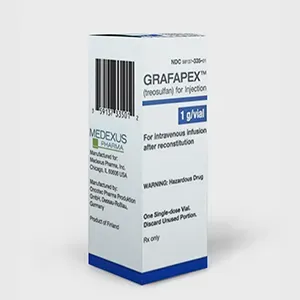Treosulfan Dosage
Medically reviewed by Drugs.com. Last updated on Mar 24, 2025.
Applies to the following strengths: 1 g; 5 g
Usual Adult Dose for:
Usual Pediatric Dose for:
Additional dosage information:
Usual Adult Dose for Stem Cell Transplant Conditioning
Treosulfan: 10 g/m2 IV once a day for 3 days (day -4, -3, -2) before stem cell infusion (day 0)
Fludarabine: 30 mg/m2 IV infusion once a day, for 5 days (day -6, -5, -4, -3, -2) before stem cell infusion (day 0)
Comments:
- This drug is administered as a 2-hour IV infusion.
- This drug should be administered before fludarabine on days -4, -3, -2.
- Premedicate the patients with antiemetics before administering this drug.
- This drug is used in combination with fludarabine. Consult the manufacturer product information of fludarabine for more information.
- Monitor for extravasation, if extravasation occurs, stop the infusion.
Use: In combination with fludarabine as a preparative regimen for allogeneic hematopoietic stem cell transplantation (HSCT) in patients with acute myeloid leukemia and myelodysplastic syndrome
Usual Pediatric Dose for Stem Cell Transplant Conditioning
1 Year and Older:
Treosulfan: 10 g/m2 IV once a day for 3 days (day -4, -3, -2) before stem cell infusion (day 0)
Fludarabine: 30 mg/m2 IV infusion once a day, for 5 days (day -6, -5, -4, -3, -2) before stem cell infusion (day 0)
Comments:
- This drug is administered as a 2-hour IV infusion.
- This drug should be administered before fludarabine on days -4, -3, -2.
- Premedicate the patients with antiemetics before administering this drug.
- This drug is used in combination with fludarabine. Consult the manufacturer product information of fludarabine for more information.
- Monitor for extravasation, if extravasation occurs, stop the infusion.
Use: In combination with fludarabine as a preparative regimen for allogeneic HSCT in patients with acute myeloid leukemia and myelodysplastic syndrome
Renal Dose Adjustments
Data not available
Liver Dose Adjustments
Data not available
Precautions
US BOXED WARNINGS:
Myelosuppression: This drug causes severe and prolonged myelosuppression at the recommended dosage. HSCT is required to prevent potentially fatal complications of prolonged myelosuppression. Monitor hematologic laboratory parameters.
CONTRAINDICATIONS:
- Hypersensitivity to the active component or any of the ingredients
Safety and efficacy have not been established in patients younger than 1 year.
Consult WARNINGS section for additional precautions.
Dialysis
Data not available
Other Comments
Administration advice:
- Inspect the reconstituted solution for discoloration and particulate matter.
- Do not use if the reconstituted solution contains a precipitate.
- If reconstituted solution is not used immediately, it can be stored at room temperature 20C to 25C (68F to 77F) for up to 24 hours. Do not refrigerate.
- Confirm patency of the intravenous line prior to infusion.
- Consult the manufacturer product information of fludarabine for more information.
Storage requirements:
- Store single dose vials at 20C to 25C (68F to 77F) with excursions permitted between 15C and 30C.
- Reconstituted solution is stable for 1 day at room temperature 20C to 25C (68F to 77F). Do not refrigerate.
Reconstitution/preparation techniques:
- This drug should be reconstituted with any one of the following before IV infusion: 0.45% sodium chloride injection, 0.9% sodium chloride injection, 5% dextrose injection, or sterile water for injection.
- The manufacturer product information should be consulted.
IV compatibility:
- 0.45% Sodium Chloride Injection
- 0.9% Sodium Chloride Injection
- 5% Dextrose Injection
- Sterile Water for Injection
Monitoring:
- General: Extravasation, intravenous infusion site for redness, swelling, pain, infection, and necrosis (during and after the dose)
- Hematologic: Blood cell counts (once a day until hematopoietic recovery), hematologic laboratory parameters
- Nervous system: Neurological adverse reactions
Patient advice:
- Read the US FDA-approved patient labeling.
- Patients should be advised to report any signs or symptoms of an infection.
- Clean sweaty skin parts (armpit, groin, genital area, inframammary line), each with a disposable washcloth and clear water.
- Do not apply any cream to the skin on the days of chemotherapy, and clothing should not be too tight, in order to let the skin, breathe.
- Females should be advised not to breastfeed during therapy with this drug and for 1 week after the last dose.
- Females of childbearing potential should be advised to use effective birth control during treatment and for 6 months after the last dose.
- Males with female partners of reproductive potential should use effective contraception during treatment with this drug and for 3 months after the last dose.
- This drug can impair fertility in females and males and may cause temporary or permanent infertility.
More about treosulfan
- Check interactions
- Compare alternatives
- Side effects
- During pregnancy
- Drug class: alkylating agents
- En español
Patient resources
Other brands
Professional resources
Other brands
Related treatment guides
See also:
Further information
Always consult your healthcare provider to ensure the information displayed on this page applies to your personal circumstances.


